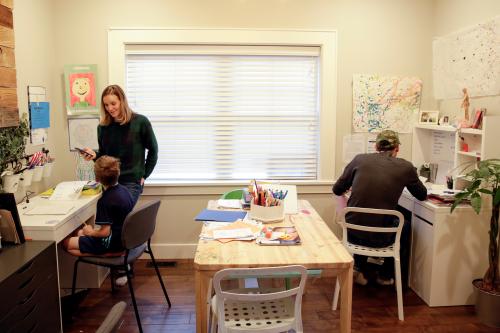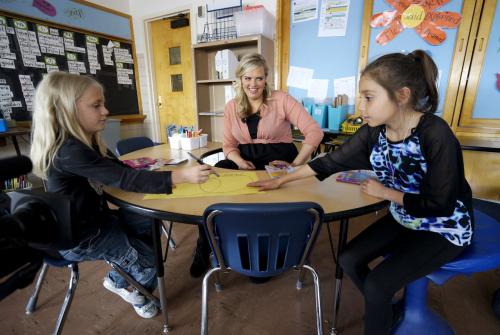Many education researchers have raised the concern that 2020 school closures have created a situation where the most disadvantaged children are most likely to lose out on the opportunity to keep learning.
A new weekly Household Pulse Survey from the U.S. Census Bureau offers a rich opportunity to quantify the impact of COVID-19 on children’s education during this time. It includes questions about the availability of digital devices and the internet in homes across the U.S., which allow us to explore the concern that access to distance learning is out of the reach of many of the most vulnerable students.
Based on four weeks of data, our findings are bleak:
Around 1 in 10 of the poorest children in the U.S. has little or no access to technology for learning. 12.2 percent of respondents from households earning less than $25,000 a year said a digital device was rarely or never available for a child to use for learning and 9.8 percent said the same of the internet.
A comparison of Week 4 data for the five richest and poorest states in the U.S. based on median household income suggests poor children living in poor states are even more likely to be at a disadvantage. Across the U.S., 4.3 percent of households earning less than $35,000 per year say a device is never available for a child’s learning. For the same income bracket in the five poorest states, this jumps to 6.3 percent, while in the five richest, it drops to 1.6 percent. Median incomes in Mississippi are just over half of those in Washington, D.C. which means, among other things, less tax revenue available for digital infrastructure or services designed to even out inequities driven by wage differences.
A similarly troubling gap in the opportunity to continue learning emerges between privileged and vulnerable children when looking at responses by other markers of economic advantage, such as employment and food security status. Nine in 10 children of employed caregivers have access to both a device and the internet for learning always, or most of the time. This on demand availability drops around five percentage points for children living in households where caregivers are unemployed.
Similarly, children living in households where food is sometimes or often in short supply lack access to the technology needed for distance education compared with their peers. Fully 26.5 percent of children living in homes where there is often not enough food to go around—more than 1 in 4—are rarely or never able to get online to learn.
The education level of caregivers is a fourth strong marker for how easily children can access online learning during pandemic related school closures. 9.5 percent of respondents across the U.S. who did not finish high school say there is rarely or never a device available for learning in their home, compared with just 1.2 percent of those with a bachelor’s degree or higher qualification. A look at Week 4 data for poor and rich states supports the idea that this disadvantage may be compounded for children based on where they live. On average for the five poorest states, only 34.2 percent of respondents who did not finish high school say the internet is always available for learning at home. By comparison, the children of 47.4 percent of respondents from the five richest states who also did not complete high school can get online on demand.
But most disturbing is the evidence emerging from this new survey that children’s access to online learning is strongly correlated with race. 8.7 percent of Black respondents say their children rarely or never have access to a device for learning, four percentage points higher than for the full sample including all races. Similarly, 6.7 percent of Black respondents say there is rarely or never internet access available in their homes, 3.1 percentage points above the full sample.
The gap in available technology for learning between households of different races is especially stark in some of the United States’ biggest metro areas. For example, while just 0.1 percent of white respondents in Los Angeles say a device is rarely or never available for learning at home, 13.2 percent of Black respondents surveyed in the same city reported rarely or never having access to a device for learning. In Detroit, this form of educational disadvantage affects children in almost 1 in 5 households that identified as Black.
These data shine a light on two major issues administrations in the U.S. must confront as they start to plan for the new academic year.
First, extra support will be critical for students whose family circumstances have made it difficult or impossible to continue learning during the pandemic. This means supporting teachers with tools to diagnose students as well as with the materials and pedagogical approaches to serve the learning needs of what is certain to be an even wider range of student skills.
Second, it will be important to plan for further periods where children need to learn from home for public health reasons, or where it may not be possible to have all students in classes and maintain appropriate social distancing. Some communities may need to adopt policies such as giving preferential access to school-based learning for the most disadvantaged, since more privileged students will be better equipped to study online. It also means designing and resourcing initiatives to improve poor children’s access to technology, either through equipment loan programs, capital investment in better internet access in relevant neighborhoods, or both.
Whether measured by income, location, parental education, or race, the relationship between privilege and access to the basic tools for distance learning is strong according to these data. Policymakers must take decisive steps to prevent the learning gap widening and damaging further the lives of children who are already at a significant disadvantage compared with their peers.
The Brookings Institution is committed to quality, independence, and impact.
We are supported by a diverse array of funders. In line with our values and policies, each Brookings publication represents the sole views of its author(s).











Commentary
Unequally disconnected: Access to online learning in the US
June 22, 2020